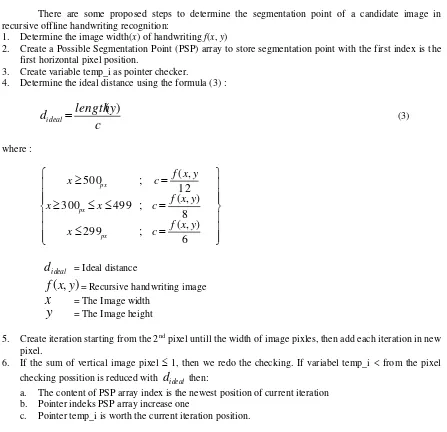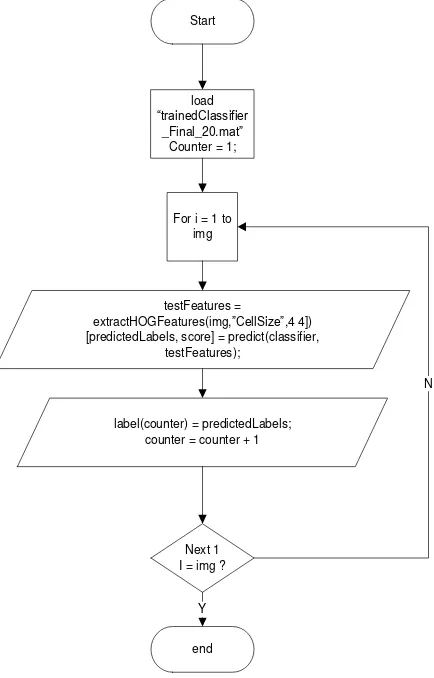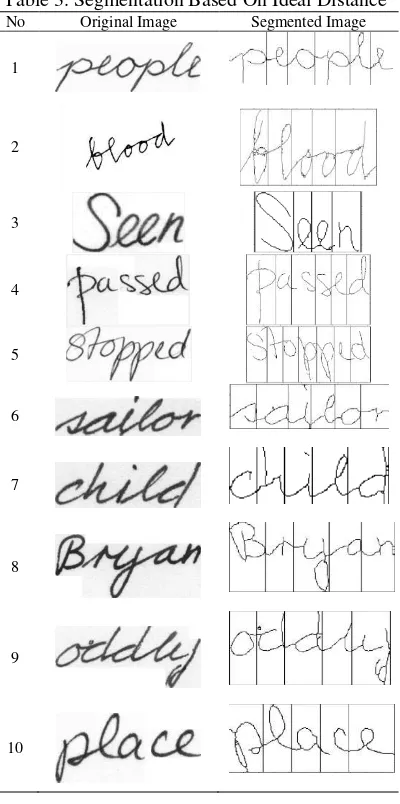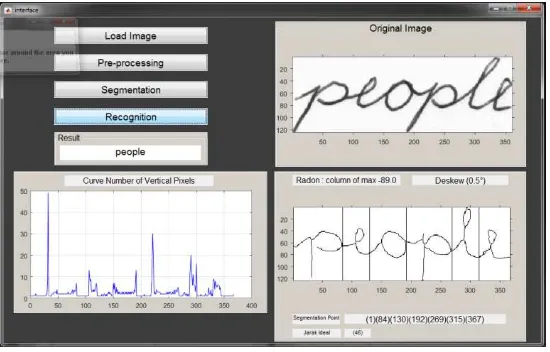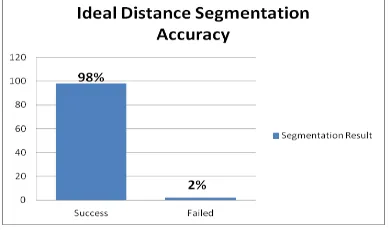ISSN: 2088-8708, DOI: 10.11591/ijece.v7i5.pp2863-2872 2863
Cursive Handwriting Segmentation Using Ideal Distance
Approach
Fitrianingsih1, Sarifuddin Madenda2, Ernastuti3, Suryarini Widodo4, Rodiah5
1, 3, 4, 5
Departement of Informatics, Gunadarma University
2Doctoral Program in Information Technology, Gunadarma University
Article Info ABSTRACT amount of handwriting varieties such as slant handwriting, space between words, the size and direction of the letter, the style of writing the letter and handwriting with contour similarity on some letters. There are some steps for recursive handwriting recognition. The steps are preprocessing, morphology, segmentation, features of letter extraction and recognition. Segmentation is a crucial process in handwriting recognition since the success of segmentation step will determine the success level of recognition. This paper proposes a segmentation algorithm that segment recursive handwriting into letters. These letters will form words using a method that determine the intersection cutting point of image recursive handwriting with an ideal image distance. The ideal distance of recursive handwriting image is an ideal distance segmentation point in order to avoid the cutting of other letter’s section. The width and height of images are used to determine the accurate segmentation point. There were 999 recursive handwriting input images taken from 25 researchers used for this study. The images used are the images obtained from preprocessing step. Those are the images with slope correction. This study used Support Vector Machine (SVM) to recognize recursive handwriting. The experiments show the proposed segmentation algorithm able to segment the image precisely and have 97% success recognizing the
Copyright © 2017 Institute of Advanced Engineering and Science. All rights reserved.
Corresponding Author:
1. INTRODUCTION
IJECE Vol. 7, No. 5, October 2017 : 2863 – 2872
The important vertexes in this study are the endpoint vertex and the vertex of the branch. Both of the vertexes will be used as the starting and ending vertex to start the searching step to find the nearest neighbor to
determine the character’s segmentation compiler. From each of the important vertex, this study explores and
investigates all possible character segmentation compilers [4]. From the input data (handwriting images), we conduct preprocessing procedure using Otsu Method then searching for the possible segmentation zone that can act as the cutting vertex. To obtain the appropriate segmentation result, Genetic Algorithm plays important role performing non-linear segmentation [5].
This study exploring vertical letter separation after skeleton methods was performed to count the amount of pixels in letter that will be used as candidate for point separator. These candidates will be evaluated based on their distance to each other. The candidates that are in seven pixels distance will be merged as a separator point. The letters used for implementation were taken using scanner of digital camera. Right and left contour analysist were carried on since Latin or Roman letter has at least one left contour [6].
Another research were exploring maximum average letter similarity to find the letter’s point for
letter separation step. All letter’s point candidate that will be used as a separator formed a graph that contain weight of letter similarity. These graphs are used to find the point separator by using average longest path algorithm. Whereas, the similarity of the letters are employed as graph’s weight. These weights were classified using SVM. The features that being classified by SVM can be extracted using histograms of oriented gradients. The oriented graph will form a cycle if 0 weight path of point separator’s candidate was added to the first candidate. This cycle reduce the difficulties of finding the average longest route to ratio maximum cycle [6].
2. RESEARCH METHOD
2.1. Data Sets
In this study, the input images were offline handwriting letters which were obtained from local dataset and IAM [7] with JPG and PNG format. The size of the images are varied with total images are 999 images. The overall images used in this study are the images with recursive handwriting characteristics. These characteristic contain; (i) normal upright recursive handwriting, (ii) italic letters in overall handwriting (slope) and (iii) tilting letter or text font (slanting). The examples of the images used in this study can be seen in Table 1.
Table 1. Experimented Image (Local and IAM Dataset)
Image
Slope
Slant
2.2. Preprocessing
y sh
=Shearing factor along y-axis x
sh
= Shearing factor along x-axis
The result of slanting correction in preprocessing step can be seen in Figure 1.
Figure 1. The result of slanting correction letter
2.3. Morfology
This study used morfologi step of Zhang Suen’s method to perform thinning process. This process is
very crucial since it was the first step before performing the next steps [8]. Thinning will eliminate the outer most layer of handwriting image pattern leaving only the line that consist of one pixel only. This line is called skeleton of the image. Each iteration of this method consist of two sub successive iteration that performed on contour point of image region, assuming a pixel with value one (1) is pixel foreground and pixel with value zero (0) is the background. An object pixel have 8-neighbor rule. The first iteration will represent Cartesian coordinate for each element as small squares. The alteration of skeleton in this study were made in binary form that is performed in one image. If the pixel in the handwriting image have at least one of its four neighborhoods (p0, p2, p4, p6) with the value less than its each grey level value or the whole eight (8) of its neighbor is less than their grey value, then its binary value turned into 1 or 0. The second iteration made during bwmorph instruction. The origin of structuring elements positioned in each of the pixel in the input image, then the value of structuring elements correspond to the pixel value.
2.4. Histogram
This study used morfologi step of Zhang Suen’s method to perform thinning process. The next step after performing recursive handwriting thinning morphology process was to obtain the image intensity information using histogram method. Histogram of a digital image has intensity level ranged between [0, L-1] with discrete function [9].
k k
n
r
H
(
)
(2)For recursive image with pixel level 0 – 225, the histogram will draw pixel frequency distribution in 0–225 interval. On the other hand, for the recursive binary image which own 0 and 1 level, the histogram will draw their frequency distribution on foreground with 1 value. The next step is to add this value vertically. The process can be seen in Figure 2.
Figure 2. Histogram of vertical image pixels quantity
2.5. Segmentation using Ideal Distance
IJECE Vol. 7, No. 5, October 2017 : 2863 – 2872
we sum up the pixel vertically, the result is a value that will be used as the segmentation point. Before examine the segmentation point, it is important to compute the ideal distance of the points in an image. The ideal recursive handwriting image distance is the ideal replacement of segmentation point in order to avoid cutting off the section of the letter in an image. As long as the spacing distance is ideal, the segmentation point cannot be done. On the other hand, after passing through the ideal spacing distance, the segmentation can be done by examining the amount of vertical pixel. The ideal spacing distance is calculated from the image width divided by the devisor that follows the width of the image in order to adjust the number of letters that contained in an image. For example, the width of the image after preprocessing step in Figure 3 is 310 pixels with the ideal spacing distance 38.75. The value 38.75 indicating subsequent to placement segmentation point, within 38.75 distance pixel is impossible to re-segment the pixel point since the distance spacing of the letter is already ideal.
Figure 3. Image with 310 x 85 pixels
Figure 4 shows the algorithm proposed in this study to determine tha devisor value dan segmentation point based on ideal distance between letters.
Figure 4. Flowchart to determine dividers value
dideal = length(x,y)/c PSP(i) = 1 indeks = 2 temp_i = 1
for i=2 : length(y)
PSP(indeks) = i Indeks = indeks+1
temp_i = 1 temp_i <
(1-dideal)
length(y)<=1 Start
End Y
Y
N
There are some proposed steps to determine the segmentation point of a candidate image in recursive offline handwriting recognition:
1. Determine the image width(x) of handwriting f(x, y)
2. Create a Possible Segmentation Point (PSP) array to store segmentation point with the first index is the first horizontal pixel position.
3. Create variable temp_i as pointer checker.
4. Determine the ideal distance using the formula (3) :
c
f
= Recursive handwriting imagex
= The Image widthy
= The Image height5. Create iteration starting from the 2nd pixel untill the width of image pixles, then add each iteration in new pixel.
6. If the sum of vertical image pixel 1, then we redo the checking. If variabel temp_i from the pixel checking possition is reduced with
d
ideal then:a. The content of PSP array index is the newest position of current iteration b. Pointer indeks PSP array increase one
c. Pointer temp_i is worth the current iteration position.
2.6. Words Feature Extraction Recognition
The training set used in this study are SVM [9]. After training the classifier using the result of feature letter by letter extraction from training set, the next step is performing feature image extraction from the test set. Test set is a set of images that contain the letters to be recognized. The result of this test set is the
letter’s weight and label that will be used for recognition step.
The steps of feature extraction and recursive offline handwriting recognition can be seen below: 1. Load 'trainedClassifier_Final_20.mat' which are the results from the training set.
2. Load the segmented image in img variable then performing feature extraction based on HOG to img. The result of feature extraction will be stored in testFeatures variable.
3. Performing score prediction to compare the result form feature extraction testFeatures variable with the score of classifier.
4. The obtained score prediction will be compared with score label of classifier and then will be loaded in label variable.
IJECE Vol. 7, No. 5, October 2017 : 2863 – 2872
Figure 5. Feature extraction and recursive offline handwritting recognition
Table 2 shows the result of feature image extraction with their weights and labels
Table 2. Image, Weight and Label from Feature Extraction
Citra Bobot Label
0.9901 s
0.9908 a
0.9925 i
0.9973 l
0.9901 o
0.9906 r
Start
load
“trainedClassifier
_Final_20.mat” Counter = 1;
For i = 1 to img
testFeatures =
extractHOGFeatures(img,”CellSize”,4 4]) [predictedLabels, score] = predict(classifier,
testFeatures);
label(counter) = predictedLabels; counter = counter + 1
Next 1 I = img ?
end Y
3. RESULTS AND ANALYSIS 3.1. Experimental Image
Segmentation process is based on segment point that being applied inside the program. This segmentation point was obtained from image column that contain vertical pixel less than or equal to one and cannot be found in ideal distance. For example, Table 3 shows 10 images out of 999 images that were successfully segmented.
Table 3. Segmentation Based On Ideal Distance
No Original Image Segmented Image
1
2
3
4
5
6
7
8
9
10
The results from segmentation point placement were not always precise and in correct position. These were due to some characteristic of recursive handwriting that differs with the printed handwriting. The differences are:
1. There is no empty space between letter in recursive handwriting, therefore the quantity of vertical pixels in segmentation point is more than or equal to one.
2. There are some letters that have characteristic as segmentation candidates. These letters have letter lines in which their vertical pixels quantity equal to one. For example U, V, W, N, M, and H.
There were also letters that are not close perfectly, For example the writing of cursive ‘a’ that was
IJECE Vol. 7, No. 5, October 2017 : 2863 – 2872
Figure 6. Letters with unsuccessful segmentation
Figure 6 shows the unsuccessful image segmentation with 3o slant of letter. Letter L and D were not correctly segmented because of the amount of vertical pixels between letter L and D ranged on y-axis between 130 until 150 pixels. The resulted pixels did not meet the conditions less than or equal one. As consequences, the cutting process cannot be done correctly at this point. The example of image recognition can be found in Figure 7.
Figure 7. The result of letter recognition
Previous research (Salvi et al, 2012) performed segmentation method on finding the separation point
of the letters using the average of maximum letter’s similarity. All the candidates of separation point will
Figure 8. Greedy algorithm segmentation result
3.2. The Result of System Perfomance
The performance measurement of offline recursive handwriting in this study was computed using ratio of successfulness and failure. The computation can be done using the formulas below:
%
The result of successful segmentation ratio and failure based on active image contour in this study can be seen in Table 4 and Figure 9.
_Success Ratio of Segmentation x The
_Failure Ratio of Segmentation x The
Figure 9. Segmentation accuracy
4. CONCLUSION
IJECE Vol. 7, No. 5, October 2017 : 2863 – 2872
(ranged between 130 until 150 pixels). These resulted pixels do not meet the conditions (≤ 1), as consequences the cutting point on those pixels cannot be perform. The accurate point to cut on segmentation step will achieve the accuracy of handwriting recognition till 98% of success.
ACKNOWLEDGEMENTS
We are indebted to the experts who have contributed towards development of the template.The authors would like to acknowledge to Gunadarma University.
REFERENCES
[1] Papandreou and Gatos, “Slant Estimation and Core-region Detection for Handwritten Latin Words.” Pattern Recognition Letters 35, pp 16-22. Elsevier. 2014
[2] Plamondon, R dan Djioua, Moussa. 2005. “Handwriting Stroke Trajectory Variability in the Context of the Kinematic Theory.” Advances in Graphonomics: Proceeding of IGS.
[3] Agrawal, Vashishtha, Kumar, “Slant Angle Estimation in Handwritten Documents,” Int. Journal of Computer Science and Management Studies. Vol. 14, Issue 5, pp. 1-5, 2014.
[4] Santos, Gabriela. Clemente, Tsang Ing Ren and Calvalcanti. “Text Line Segmentation Based on Morphology and Histogram Projection,” 10th International Conference on Document Analysis and Recognition, 978-0-7695-3725-2/09, IEEE. 2009
[5] Saba, Su Long, and Rehman. “Non-Linear Segmentation of Touched Roman Characters Based on Genetic Algorithm.” International Journal on Computer Science and Engineering (IJCSE). Vol. 02, No. 06, pp 2167-2172. 2010
[6] Choudhary, Rishi, and Ahlawat. “A New Character Segmentation Approach for Off-Line Cursive Handwritten Words. Information Technology and Quantitative Management (ITQM2013).” Procedia Computer Science 17, pp 88-95. Elsevier. 2013
[7] IAM Handwriting Database, sumber: http://www.fki.inf.unibe.ch/databases/iam-handwriting-database, Tanggal akses : 18 November 2016
[8] Fitrianingsih, Sarifuddin Madenda, Suryarini Widodo, Rodiah, “Slant Correction and Detection for Offline Cursive Handwriting using 2D Affine Transform,” International Journal of Engineering Research & Technology, ISSN. 2278-0181, Vol. 5 Issue 8, pp. 568-572, August 2016
[9] Catalin and Ruxandra, “Support Vector Machines and Evolutionary Algorithms for Classification.” ISBN. 3319069403. Pub. Springer Verlag Gmbh. pp. 78-114. 2014


